It is a Friday in mid May when we set out to find Croghan Hill in County Offaly. The roadside is brimming with mayflower (hawthorn) blossoms and wayside herbs at the peak of their bloom time.
We’d only arrived in Ireland the evening before and are up at the crack of dawn, not at all recovered from jet lag and the 36+ hours in transit from Australia. But the fresh air and beauty of the green countryside and spring wildflowers is enlivening as we drive in the cool, early morning air.
Just a kilometre or so out of the small town of Croghan, the road is blocked by roadworks. None shall pass! So we abandon the car and begin to walk the final kilometres into town. Croghan Hill is already in view, its small teat-like cairn visible atop the long green mound that looms above the village.
As we reach the edge of Croghan or Cruachán, an old blacksmith’s stone building greets us. Fitting indeed for it is said that Bride herself, an experienced blacksmith, had her workshop below the sacred mound of Croghan, where she forged beautiful cauldrons.
There were three Bride/Brigids, daughters of the Dagda or ‘good god’ of the Tuatha de Danann (the mysterious people of the goddess Danu who reigned in Ireland before the Milesians). Each Brigid was learned in her field - Brigid the smith (Begoibne), Brigid the poet or wordsmith, and Brigid the healer.
Indeed it is said that Brigid was born in the bogland that surrounded the ancient volcanic plug that is Croghan Hill. In the distant past, the hill would have emerged as an island out of the lakes below.
Today the surrounding area is known as The Bog of Allen, though there is a possibility that Allen came from Eile (Áillen meaning ‘beautiful’),[i] for the older name for Croghan Hill was Cruachán Bri Éile.
Cruachán in some sources means ‘a small hill or mound’, yet it also pertains to an ancient mother goddess variously known as Croghan, Cruachain or Crochen.
Yet there is another woman associated with this sacred mound - Ele or Eile - the sister of the famous mythological figure - warrior Queen Maeve. It is said that one of the cairns atop the hill, contains Eile and her chariot, and as the cairns have never been excavated, we can only suppose she stands there still.
A sign in town tells us the hill was named for the daughter (Ele) of the King who divided Ireland into five provinces, and that local kings were inaugurated upon it. This gives us some inkling into its sacred status, for the sacred marriage occurs at sacred mounds that give access to the otherworld – so that the feminine deity can come forth to consecrate the kingship. (I’m exploring this theme in depth in the serialisation of Waking the Wellsprings.)
Croghan hill or Bri Ele is a gateway into Ele’s otherworldly realm. In The Boyhood Deeds of Fionn[ii], Ele is described as a beautiful maiden who lived in the fairy knoll of Bri Ele. So appealing was she, that the men of Ireland fought to woo her. The wooing would take place each year at Samain, as that was the time when the veils were thin so that even the fairy mounds and what lay within couldn’t be hidden. But whichever man that went to woo Ele, one of his men was slain and no one could ever discover how it happened or by whom.
While Bri is often used to refer to a fairy mound, another source[iii] suggests it could refer to Bride – making it ‘the rock or hill (cruachan) of the beautiful (eile) Bride (Bri)’.
Whatever the case, the ever green goddess Brigid seems to have resisted the tests of time where the other feminine deities have become somewhat lost in the mists. Yet how fitting that the mound should be associated with three feminine deities.
Cruachán Bri Éile. A triple spiral of otherworldly deities that reside in the mound.
Even without knowing much of this when we visited, we can feel the the spirit of the mountain is feminine, and she is strong.
We find the little green leaved path that climbs out of the village and commence our ascent. Either side of us, gorse shines brightly with yellow flowers, the soft greens of nettle intersperse with wayside herbs at our feet, and bushes of hawthorn drip with their white-pink blooms. We come to a stile in an open field and I turn to look back at the slowly evolving view below and who should come running through the herb laden grass, but a friendly tabby cat. I greet her with a pat and we continue up the mountain in a sea of green. She follows us and we spontaneously call her Etain after the solar fae goddess who was mother to Croghan.
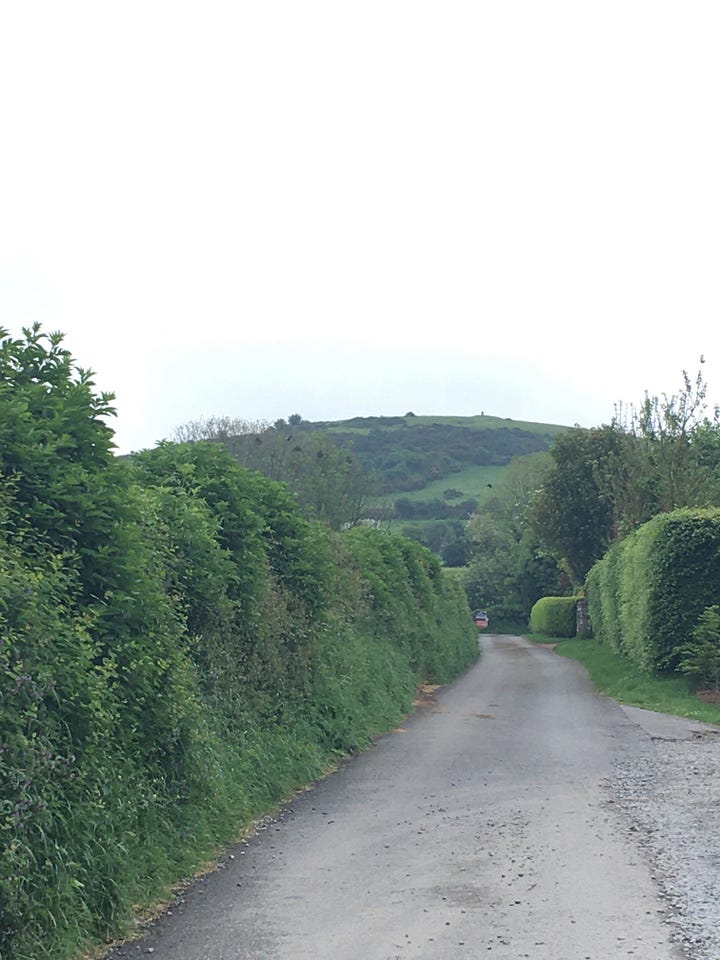
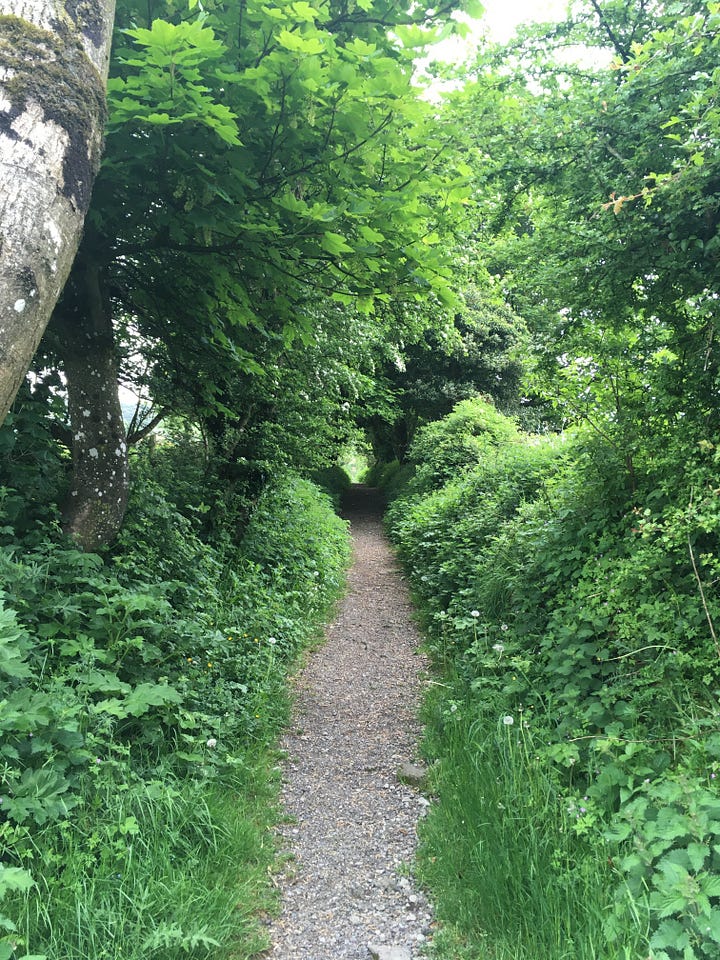


The path opens out and to the left is a stone fenced area with what appears to be a cemetery within its walls. In the other direction lies a flowering meadow path up to the top of the hill. We swing toward the cemetery to take a quick look, though can’t see a way over the stone wall. Etain however, knows the way and promptly bounds gracefully up some steps built into the stone that we hadn’t noticed and sits atop the fence gazing back at us.
Etain, our personal guide!
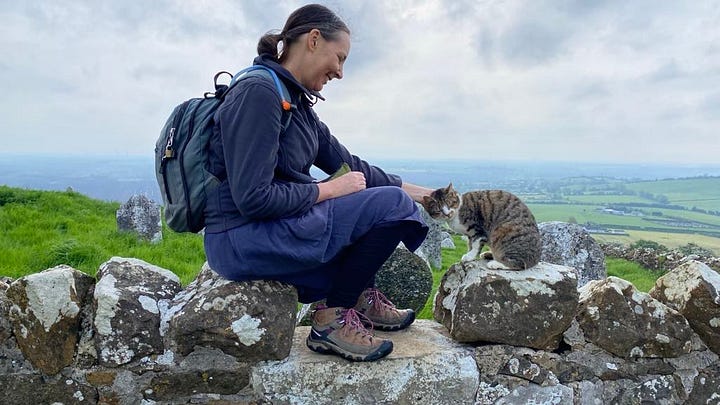

It is the site of an old church, believed by some to be the first convent of Brigid and where she received the veil (though a similar story is told elsewhere, which we’ll come to later). You can read more about Bride and the legend of her birth in this article:
A small ditch here in the mountain near a lone tree, and we wonder if this was one of the one of the many wells associated with the mountain (stay tuned for a separate article on this.)
We cross back from the cemetery to climb the green mountain. It is covered in wildflowers and the beautiful mountain goddess can be felt with every breath and step we take.
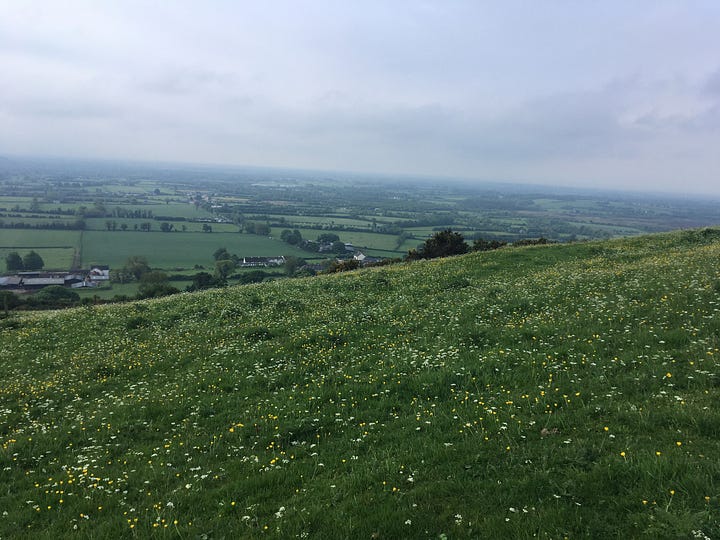
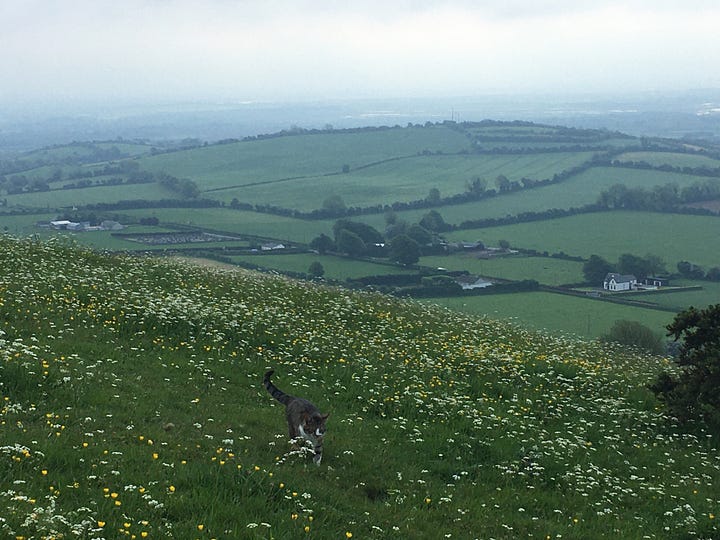
At the base of the nipple mound, we sit for a cup of tea sheltered at her breast from the cold winds that blow above. The view is expansive, the little village of Croghan far below. Etain takes turns sitting on each of our laps, purring her heart out. We go into blissful purr realms together.
There’s nothing quite so sacred as the purring vibration of a cat enjoying adoration and touch. It gives as much as it receives – the sacred mystery teachings of the feminine embodied!
A stela sits atop the green teat of Croghan, decorated in creative art and words that honour the different aspects of the sacred mountain – its volcanic power, the springs that run from it (another article about that), Bride, and old Croghan man.
In 2003, a 2 metre tall man of high status and possibly royalty was discovered preserved in the bog peat that surrounds the mountain. Old Croghan Man as he is now known, dates back to between 362-175BCE and is thought to have been ritually killed - a possible sacrifice to the mountain goddess?. Could he be one of the men who mysteriously died in the wooing of Ele??
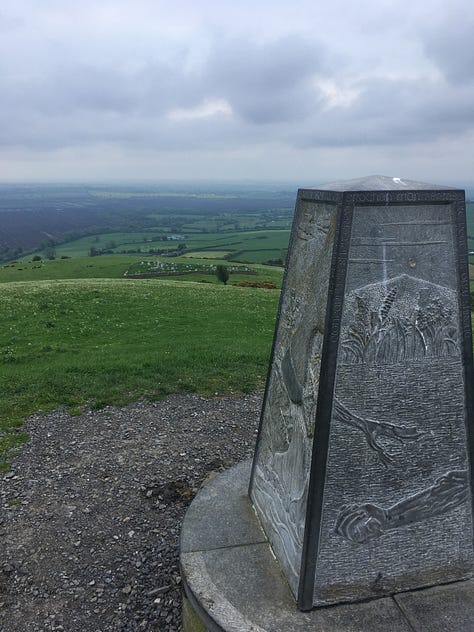
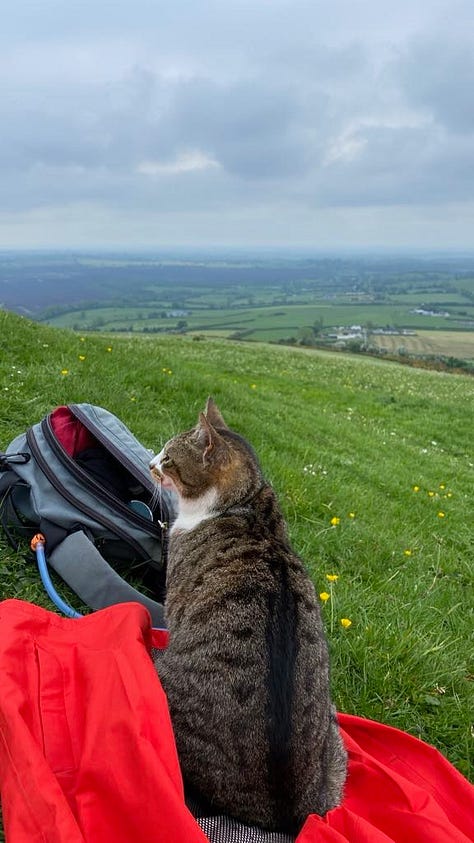
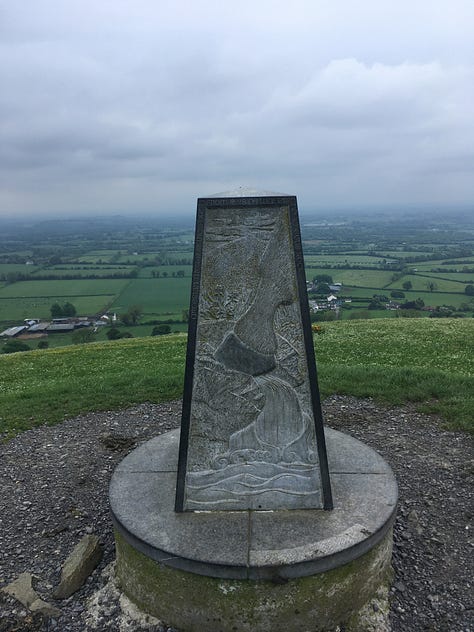
Croghan/ Cruachán/ Cruacháin/Crochen
There is little to be found about ancient Crochen or Croghan, though her name has remained within several significant sacred sites in Ireland.
She is mother of Maeve and daughter of Etain.
Could that mean she is also mother of Eile, Maeve’s sister?
Roberts[iv] tells us she is an ancient mother goddess who created the land and its sacred places as she flew above, dropping stones from her apron which created sacred sites where they fell. This is the same legend of Cailleach (see my Chasing the Hag series of articles).
Are they the same great mother figure, or was Crochen a Cailleach, one of the many great mother/crone/hag figures of Ireland?
Roberts also tells us her name means ‘a cup or drinking vessel’ though it’s unclear where this information comes from. It brings interesting associations however, as the cup or vessel (womb) that her daughter Maeve is born of, whose name in turn, (Maeve/Mebd) means ‘intoxicating one’. It’s from this that mead derives, the sacred drink that was offered via a cup by the fairy queen to the mortal King, which sanctified their sacred marriage and his right to Kingship. (Again see Waking Wellsprings for more on this theme). Like Cailleach, she is a greater mother figure, the mother of the goddess.
The Ley of Cats
I had been drawn to visit Croghan after reading a book: The Power of Centre by Biltcliffe and Hoare.
Several years earlier I’d had a dream of a place with a strange name - Uisneach. I’d never heard of it (and never been to Ireland at the time), but looked it up the next morning to discover it is an ancient site in the centre of Ireland that marks the division of the five ancient provinces. A few years later I am very excited to discover the above book which covers topics I’d been receiving inner information of, but knew nothing about in the physical realm.
In one chapter, they discuss a Brigid Line: a southwest angled ley line that joins Kildare (the place of Bride’s perpetual flame and healing waters), Croghan Hill at the centre (with Bride as smithy of cauldrons and also her birthplace) and Uisneach, which also has associations with Bride being the place of poets ‘Aonachs’[v]. The three Bride’s and their triple aspects all in a neat line of sacred sites on the axis of the midwinter solstice sunrise.
On my first ever day in Ireland, and at our first visit to a sacred site in the country, we are greeted, guided and accompanied by a cat.
A cat guardian of a sacred mountain that is known in folk memory[vi] as the navel (or true centre) of Ireland.
But curiouser still, was to find the mysterious cat connection in other sites we visited. Could it be there is a Ley of the Cat in Ireland?!
In the next articles, I’ll explore some of these connections with cats, Croghan, sacred mounds and myth.
I hope you enjoyed reading! Articles take time to research and write. To support my continued work, please consider liking and sharing this post, subscribing for free, upgrading to paid, or purchasing one of my books or courses at wildflowerwalker.com. Thank you for your awesome support.
Go to Part 2:
The Mystical Ley of Cats in Ireland: Uisneach's Catstone.
In the previous article in this series: a cat guided us around the ancient umbilical mound of Bri Ele (Croghan Hill) in Ireland. Having this beautiful experience with a cat on a sacred otherworldly f…
About Heidi
I’ve been walking the plant spirit path for close to 30 years. With herbalism, homeopathy, and plant alchemy/spagyrics as early companions, midwifery and shamanism came a little later. After years of listening to the plants, I’ve since taught hundreds of people how to deepen their connection with nature and learn to hear the whispers of plants. I continue to offer The Flower Codes Training/ Shamanic Herbalism online course, as well as various in person shamanic nature-based courses such as Herbal Alchemy Spagyrics.
My published books include:
"The Flower Codes: Plant Spirit Teachings for your Soul to Blossom."
"Wild Flower Walker: A Pilgrimage to Nature on the Bibbulmun Track”;
and Blue Triangle Butterfly: A Homeopathic Proving
Bibliography
Biltcliffe, G. &. Hoare, C. (2018). The Power of Centre. Dorset: Sacred Lands Publishing.
Brideson, J. (2017). Searching for Brigid's Well. Retrieved from The Ever-Living Ones: Irish Goddesses & Gods in Landscape, Myth & Custom.: https://theeverlivingones.blogspot.com/2017/01/searching-for-brigids-well.html
Religion, A. (2014). Brigid, Croghan Hill and the Bog of Allen. Retrieved February 2025, from The Atlantic Religion: A 'Prisca Theologia' of European Paganism: https://atlanticreligion.com/tag/cruachan-bri-eile/
Roberts, J. (2016). The Sacred Mythological Centres of Ireland. Bandia Publishing.
The Boyhood Deeds of Finn mac Cumhaill. (1936). In T. &. Cross, Ancient Irish Tales. (p. http://www.ancienttexts.org/library/celtic/ctexts/f02.html). New York: Henry Holt & Co.








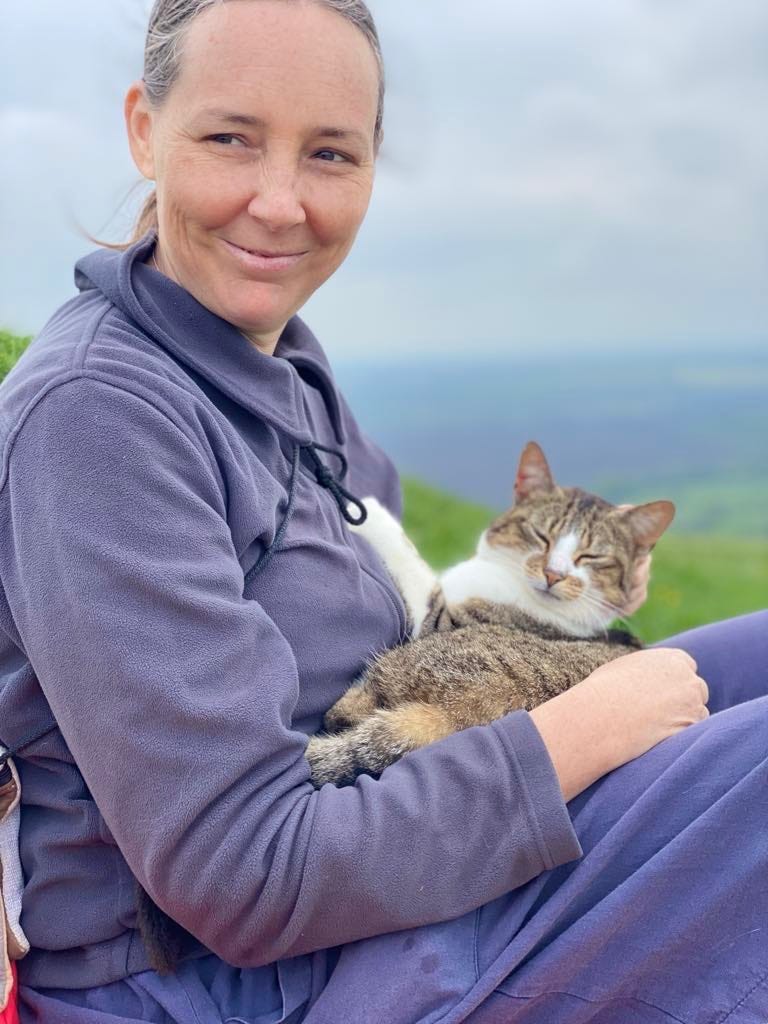

How magical, your experience and your writing! Thank you so much for sharing.
Wondering if Ele has some relationship to Elen of the Ways? Could the Ley of Cats be the leylines once traveled by Elen (or her transformed self as reindeer)?